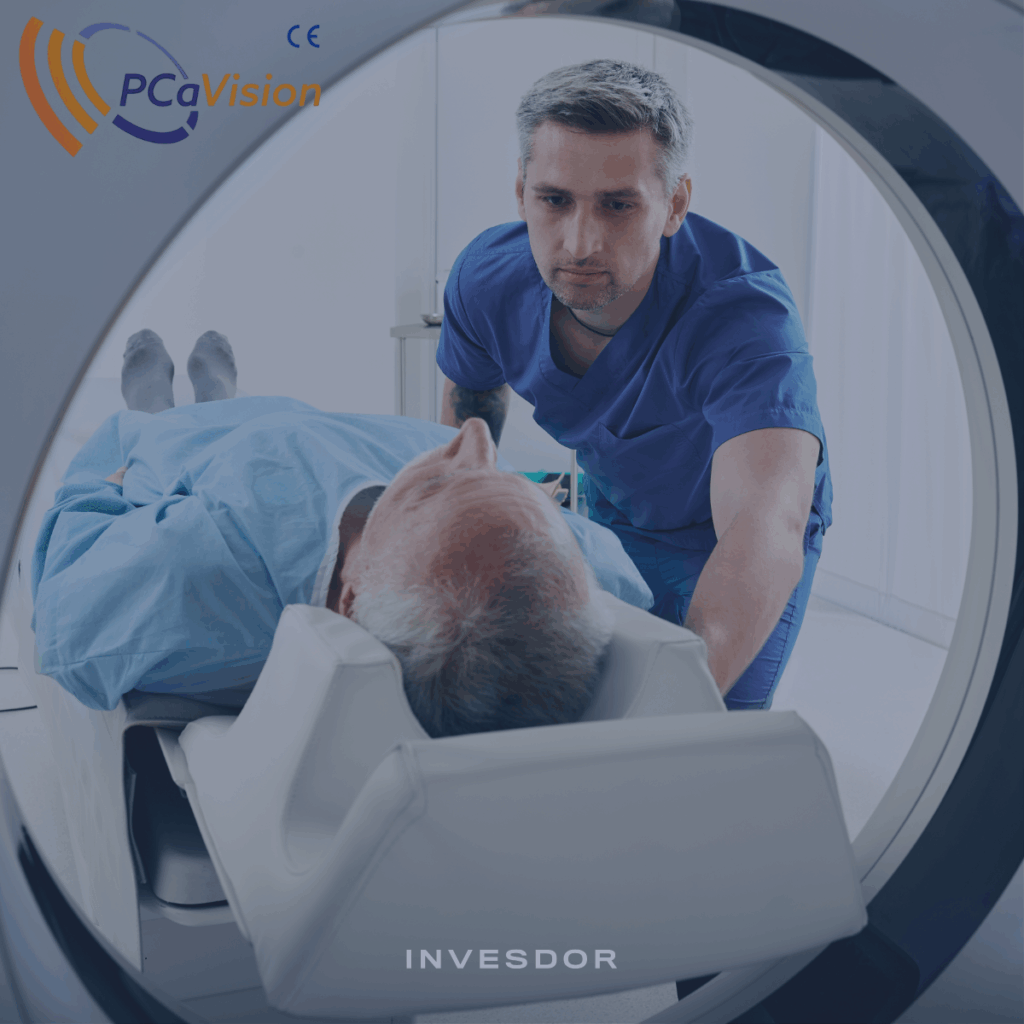Detect prostate cancer earlier: How PCaVision helps patients and appeals to investors

Prostate cancer is one of the most common cancers in men. Every year, over ten million screenings are performed worldwide to detect it early. Yet today, diagnosing prostate cancer is often slow, expensive, and reliant on scarce MRI capacity. The result: long wait times, stressful uncertainty, and avoidable interventions.
Table of contents
PCaVision offers a new way to make diagnostics more efficient, faster, and accessible. The Dutch MedTech company is developing an AI-powered prostate cancer diagnostic tool based on ultrasound, enabling urologists to make a diagnosis in a single session —without MRI and without radiologists.
In doing so, PCaVision addresses a care gap that is only set to grow in the coming years. That’s why this project is also compelling for investors: it combines medical benefit, impact investing in healthcare, and a scalable SaaS model with strong growth potential.
Prostate cancer – an urgent health challenge
A common disease. A diagnosis that takes time and energy.

Prostate cancer is one of the most frequently diagnosed cancers in men. Global demand for diagnostic procedures is growing by about 10% each year. By 2040, demand is expected to double. Reasons include:
- An aging population
- Expanded preventive care programs
- Growing awareness of prostate cancer screening
1. Waiting for the exam – often for weeks
Suspected prostate cancer is stressful. Many patients wait weeks for an MRI appointment due to limited radiology capacity. This creates uncertainty and delays potential treatment.
2. Multiple appointments, more effort
DThe standard process looks like this:
- Suspicion raised during a urologist visit
- Referral for MRI
- MRI result from a radiologist
- Follow-up with the urologist
- Targeted biopsy
The result: delays, extra steps, and numerous appointments.
3.Invasive procedures, often unnecessary
The alternative to MRI is a systematic biopsy involving multiple tissue samples—even if no clinically relevant cancer is found. This places a physical and mental burden on patients.
4. Capacity issues across the system
Urology and radiology departments are already stretched thin. Overloaded diagnostic structures mean longer wait times and case numbers continue to rise.
In short: the system is reaching its limits, and the ones suffering are the men who need clarity.
PCaVision streamlines the lengthy diagnostic process
PCaVision accelerates diagnosis by combining AI and ultrasound. The technology is clinically validated, CE-certified, and already in use in pilot clinics.

How does it work in practice?
- The urologist uses a standard 3D/4D ultrasound probe
- PCaVision analyzes the data automatically
- The software generates a color-coded heatmap highlighting suspicious areas
The physician can perform targeted biopsies in the same session
A diagnostic process that used to take weeks is now completed in just 20–30 minutes.
Benefits for patients: clearer, less stressful, faster diagnosis
1. Faster diagnosis enables earlier treatment
Many men spend weeks in uncertainty. PCaVision drastically reduces this time. Early, clear diagnoses improve the chances of detecting cancer at a treatable stage.
2. Less physical strain
Targeted biopsies instead of “blind” sampling mean:
- Fewer punctures
- The physician can perform targeted biopsies in the same session
- Less post-procedure discomfort
Studies show unnecessary biopsies can be reduced by up to 75%.
3. No additional appointments, everything in one session
Patients no longer need to wait for MRI slots, organize travel to radiology centers, or coordinate multiple doctor visits. This saves time, reduces stress, and makes the process more predictable.
4. MRI-level diagnostic quality, but more accessible
PCaVision matches MRI in detecting clinically relevant tumors, but it’s significantly more affordable and can be used wherever ultrasound is available.
5. Greater equity in access to care
In many regions, MRI access is limited. This technology enables diagnostics in places where patients previously faced long waits. For men in rural or underserved areas, that’s a real advantage.
In short: PCaVision gives patients earlier clarity, reduces their burden, improves access to diagnostics and relieves the pressure on the healthcare system.
Why this matters to investors
Because patient benefits are directly tied to economic potential. The bigger the medical problem, the stronger the market and the clearer the need for a better solution.
1. A large, growing market
Over 10 million diagnostic procedures globally each year
Growth: ~10% annually
By 2040: expected to double
This is a huge market, and PCaVision addresses a critical bottleneck.
2. A solution that truly relieves the system
The technology shortens diagnostic times from weeks to minutes. That means real capacity gains, cost reduction, and higher efficiency.
For clinics, that translates to:
- Faster workflows
- Less dependency on MRI
- Economic benefits
A product that cuts costs while improving care quality has strong chances for widespread adoption.
3. A scalable SaaS business model
PCaVision earns per scan, not per device. That means:
- Recurring revenue
- Predictable income
- High margins
- Low variable costs
- Strong scalability
Every clinic becomes a long-term revenue driver.
4. Clinically validated, CE-certified, early customers onboard
The company is no longer a research project, it’s a product in the market. This maturity reduces tech risk for investors.
5. Strong institutional backers
The Series A is supported by:
- NLC Health Impact Fund
- CbusineZ
- TU/e Holding
- Family offices and experienced angel investors
Private investors participate via Invesdor on the same preferred share terms as these institutional investors, meaning equal economic rights.
6. Impact investing with measurable value
This healthcare technology:
- Speeds up diagnoses
- Reduces unnecessary procedures
- Improves access to care
- Relieves pressure on healthcare systems
… fulfilling SDG 3: “Good Health and Well-being.”
Investing in PCaVision means tackling a socially relevant problem, with potential for financial upside.
7. Attractive exit options in MedTech
MedTech companies with strong clinical evidence and scalable models are frequently acquired. Potential outcomes include:
- Strategic acquisition by imaging or diagnostics giants
- Series B funding at a higher valuation
- Regional licensing or distribution partnerships
As market adoption grows, so does company value and investor potential.
What matters:
Investing in growth companies carries risk, including total loss.
At the same time, this market often offers a compelling risk-reward ratio.
A rational checklist:
- Is the market big enough? → Yes: growing, driven by demographics and medical need
- Does the company solve a real problem? → Yes: a genuine and growing care gap
- Is the product validated and market-ready? → Yes: CE-certified, early clinics onboard, strong data
- Is the business model scalable? → Yes: SaaS with recurring revenue
- Are experienced investors involved? → Yes: institutional and strategic partners
For many investors, PCaVision is compelling: it combines medical value, measurable impact, and a scalable tech model, a rare combination in the MedTech space.
Conclusion: why now may be the right time
PCaVision is at the intersection of technology, market, and timing. The clinical evidence is strong, early adopters are in place, the product is ready and the healthcare problem is only growing.
Those looking to invest in companies that:
- Drive medical progress
- Address real care gaps
- Offer clear growth potential
… will find in PCaVision a project with clear relevance and solid foundations.
Find out more now and invest in MedTech: your opportunity to help shape the future!
👉 Visit PCaVision’s investment page
Disclaimer: Please read the risk disclosures and documentation carefully. Investing in securities of growth companies can result in a total loss of invested capital.







